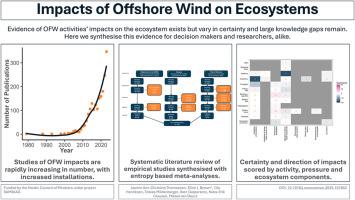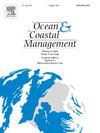Case-dependent impacts of offshore wind farms on ecosystems: A systematic review and meta-analysis
IF 5.4
2区 环境科学与生态学
Q1 OCEANOGRAPHY
引用次数: 0
Abstract
The need for diversification of energy sources is driving the expansion of offshore wind farms, which is, in turn, amplifying their impact on marine ecosystems. Understanding the impact of different wind energy associated activities on ecosystems is crucial for developing effective management strategies that balance the benefits of offshore wind energy production with the risks to biodiversity and ecosystem functioning. The present work systematically reviews (PRISMA), critically assesses, and synthesizes in meta-analyses evidence of impacts from activities and associated pressures of offshore wind energy production. A total number of 129 scientific publications investigating the ecological impacts of offshore wind farms in the period from 2003 to 2024 were collated. Almost three-quarters (74 %) of the identified publications were focused on the northeast Atlantic, where installations are the most abundant. The introduction of novel habitat was the most frequently reported pressure associated with the presence of offshore foundations. The most common impacts were reported on seabirds and cetaceans, with high agreement in the literature of a negative impact during both the operational and installation phases. The results highlighted that only around one third of all theoretical interactions between ecosystem components and activities were addressed. The impacts from offshore activities linked to transmission cable installation and operation, as well as routine maintenance, and decommissioning in general, were least studied. This gap is especially relevant considering the prospects for already established offshore wind farms and the expected industry expansion. The visual and detailed synthesis of evidence is a valuable summary for decision-makers, practitioners, developers, industry and researchers informing the offshore wind sector. Generalisable impacts can directly inform decisions; while monitoring and future research can be prioritised by context dependent impacts and knowledge gaps.

海上风电场对生态系统的个案影响:系统回顾和荟萃分析
对能源多样化的需求正在推动海上风力发电场的扩张,这反过来又放大了它们对海洋生态系统的影响。了解不同风能相关活动对生态系统的影响对于制定有效的管理策略至关重要,这些策略可以平衡海上风能生产的好处与对生物多样性和生态系统功能的风险。目前的工作系统地回顾(PRISMA),批判性地评估,并综合了海上风能生产活动和相关压力的影响证据。对2003年至2024年期间调查海上风电场生态影响的129篇科学出版物进行了整理。近四分之三(74%)的已确定出版物集中在东北大西洋,那里的设施最丰富。引进新的生境是最常报告的与近海地基存在有关的压力。据报道,最常见的影响是对海鸟和鲸类动物的影响,在操作和安装阶段的文献中都有高度一致的负面影响。研究结果强调,只有大约三分之一的生态系统组成部分和活动之间的理论相互作用得到了解决。与传输电缆安装和操作有关的海上活动,以及常规维护和退役的影响,研究得最少。考虑到已经建立的海上风力发电场的前景和预期的行业扩张,这一差距尤其重要。可视化和详细的证据综合为决策者、从业者、开发商、行业和研究人员提供了宝贵的总结,为海上风电行业提供了信息。一般影响可以直接为决策提供信息;而监测和未来的研究可以根据环境相关的影响和知识差距来确定优先次序。
本文章由计算机程序翻译,如有差异,请以英文原文为准。
求助全文
约1分钟内获得全文
求助全文
来源期刊

Ocean & Coastal Management
环境科学-海洋学
CiteScore
8.50
自引率
15.20%
发文量
321
审稿时长
60 days
期刊介绍:
Ocean & Coastal Management is the leading international journal dedicated to the study of all aspects of ocean and coastal management from the global to local levels.
We publish rigorously peer-reviewed manuscripts from all disciplines, and inter-/trans-disciplinary and co-designed research, but all submissions must make clear the relevance to management and/or governance issues relevant to the sustainable development and conservation of oceans and coasts.
Comparative studies (from sub-national to trans-national cases, and other management / policy arenas) are encouraged, as are studies that critically assess current management practices and governance approaches. Submissions involving robust analysis, development of theory, and improvement of management practice are especially welcome.
 求助内容:
求助内容: 应助结果提醒方式:
应助结果提醒方式:


